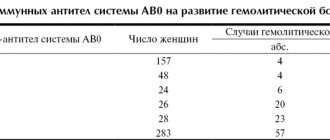Types and causes of post-term pregnancy: true and prolonged, what is the difference?
The content of the article
A true post-term pregnancy is considered a complication in which a full-term mature fetus is not born due to lack of labor or other reasons. Its development stops and the child becomes overripe. This is very dangerous for both mother and child - he will face multiple complications and birth injuries, the consequences of which will have to be treated throughout his life.
During a prolonged pregnancy, the fetus may be large, but its health is almost normal. This is due to the opposite reasons that caused the post-maturity.
The reasons for true post-term pregnancy are different, so it is difficult to insure yourself against this condition. For example, a delay in the birth process can be caused by:
- Hormonal imbalances associated with improper functioning of the ovaries, pituitary gland, and thyroid gland.
- Previous surgical abortions, tumors (fibroids, fibromyomas) leading to disturbances in the neuromuscular regulation of the uterus.
- Taking medications to maintain pregnancy for a long time. In some women, these drugs subsequently cause inhibition of the processes that cause labor.
- Age-related first births.
- Narrow pelvis, malpresentation of the fetus (pepper, oblique). In this case, the fetus does not put pressure on the cervix, it remains unprepared and the labor process does not begin.
- Psychological problems - panic fear of childbirth, fear of having a child, fear of not coping with difficulties.
Unlike a truly post-term pregnancy, a falsely post-term (prolonged) pregnancy is not so dangerous for the baby and mother.
Her reasons:
- Individual characteristics
of the mother and child. Some children take a little longer to fully mature. - Heredity
. In some families, all women carry over, giving birth to very large children. In medicine, cases of newborns weighing 7-9 kg have been described. - Incorrect determination of the due date
. Sometimes, especially if the baby is large, doctors may make a mistake about the gestational age. Often, when registering, women do not remember the date of their last menstruation, and it is indicated approximately.
With a prolonged pregnancy, labor will begin on its own, but a little later there is no point in inducing it, and even more so, operative delivery if the baby is feeling well.
How to determine that the PDR has passed?
First of all, you need to see a doctor. Together with him, you will once again determine the expected due date: this calculation can be made, focusing on the first day of the last menstruation, on the first movement of the child (if you are becoming a mother for the first time, you will feel it in the 20th week of pregnancy, if the second or third - at the 18th week), based on ultrasound scan data.
If a post-term pregnancy is accompanied by various “aggravating circumstances”: for example, the expectant mother is over 30 years old and this is her first birth, or the baby is positioned “incorrectly” (legs or bottom forward), doctors will prefer to perform a cesarean section on her without waiting for the onset of labor.
In addition, you can calculate the due date and the number of weeks of pregnancy using a regular or special round pregnancy calendar, which, by the way, was published in the magazine “Happy Parents” (autumn 1999). Perhaps, as a result of the calculations, you will discover an error in the duration of your pregnancy, and then you will have to patiently wait for the contractions to begin... But if the estimated due date still turns out to be quite accurate, you will need to undergo a small examination.
First, the doctor will examine you and listen to the baby’s heartbeat, then send you for an ultrasound examination, which will help determine the baby’s condition, his height, weight, as well as the amount of amniotic fluid and the degree of aging of the placenta. It is known that by the 36-37th week the growth of the placenta stops and by the end of pregnancy its thickness is approximately 3.3-3.6 cm. In other words, the placenta “ages”: it becomes thinner and can no longer supply the child with the necessary amount of oxygen . Because of this, the baby experiences a lack of oxygen - hypoxia (it is determined by listening to the fetal heartbeat, and the diagnosis is confirmed using a cardiac monitor). Then, towards the end of pregnancy, the amount of amniotic fluid decreases and, if a woman “overstays” her term, then, most likely, during an ultrasound, doctors will discover that she has oligohydramnios.
A truly post-term pregnancy is a disaster for mother and baby
During a post-term pregnancy, many problems arise.
Due to the aging of the placenta, which cannot fully supply the child’s body with oxygen, hypoxia occurs. Nature preserves the baby’s life to the last, redirecting the reduced flow of oxygen and nutrients to vital organs (heart, liver, kidneys, brain), while the skin and subcutaneous tissue suffer.
The work of the sebaceous glands slows down, the cheese-like lubricant covering the baby’s body is washed off and disappears. Because of this, the skin, left unprotected in a liquid environment, becomes wet. It turns out that the child is in a kind of “bathtub” for 24 hours. Because of this, sagging and wrinkled skin of the legs and arms (“bath” feet and palms) appears. The skin becomes irritated and flaky.
Due to hypoxia, intrauterine passage of meconium occurs. Exposure to yellow-green stool aggravates skin manifestations. During birth, the skin and ears have an unusual greenish-yellow tint.
Gradually, all organs cease to have enough oxygen. Serious complications arise:
- Brain lesions
. Hypoxia causes the death of brain cells. In such children, mental retardation and disturbances in the functioning of the nervous system are observed in the future. - Aspiration of original feces.
Meconium entering the respiratory tract causes irritation. It is especially dangerous if feces enter the trachea. When the baby begins to breathe on his own after birth, particles of meconium will enter the lungs and bronchi, causing breathing problems. Such children breathe heavily, using all the muscles of the chest. This is noticeable by the widened wings of the nose, retracted intercostal spaces and sternum, blueness of the nails and nasolabial triangle. 10% of newborns with this pathology die in the first days after birth. - Liver lesions.
In overripe babies, jaundice occurs due to liver damage, the poor functioning of which poisons the entire body. Unlike healthy children, in whom the yellowness of the skin goes away by 5-7 days without treatment, in late births it persists for a very long time. After birth, the baby will need extensive pediatric care.
Post-term pregnancy is a reason for hospitalization and urgent delivery. Stimulation is carried out, and if it does not produce results, surgical delivery is carried out. Women in labor with a narrow pelvis and malpresentation of the fetus immediately undergo a cesarean section.
Prevention of post-term pregnancy
Prevention of these complications is similar to prevention of all other pregnancy pathologies. Women who have endocrine diseases, suffer from chronic infectious and inflammatory processes, and have experienced frequent intoxication are at risk of post-term pregnancy. Such patients should be especially careful in determining the timing of delivery.
To prevent the development of complications during post-term pregnancy, your doctor may take the following measures:
- determine the expected date of birth as accurately as possible;
- choose a fully fortified diet for the period of pregnancy;
- send to classes on physical and psychological preparation for childbirth;
- hospitalize at 39-40 weeks with an immature cervix;
- perform ultrasound to monitor the state of placenta maturity;
- carry out accelerated preparation of the cervix for childbirth after 40 weeks.
For the pregnant woman herself, it is important to maintain an active lifestyle throughout the entire 9 months, and to walk in the fresh air more often.
What is the difference between childbirth during post-term and prolonged pregnancy?
The birth of overmature children is often accompanied by premature rupture of amniotic fluid, weak or discoordinated labor.
Such newborns have denser bones and considerable weight, which makes it difficult for them to pass through the birth canal. If in an ordinary fetus the bones of the skull “run into” each other at birth, reducing the size of the head, then this does not happen with late birth. This leads to birth injuries to the head and fractures of the child’s collarbones. Newborns have to be removed using forceps or a vacuum. All this aggravates the already difficult condition of children.
Post-term babies are often born in a state of white or blue hypoxia, cry poorly and breathe heavily. They have a dysfunction of the nervous system. Children constantly cry, do not sleep, and there is constant trembling of the limbs, lips and lower jaw. The swallowing and sucking reflexes are reduced. There may be cramps and constant vomiting. Such newborns often subsequently lag behind in development, suffer from autism, epilepsy and cerebral palsy.
Even with the modern development of medicine, the number of stillbirths or the birth of children with severe pathologies during true postterm pregnancy reaches 30%.
Women often experience ruptures of the cervix, perineum, and sometimes the rectum. In severe cases, bleeding may occur due to poor contraction of the uterine muscles. To save the life of a woman in labor, in exceptional cases it is necessary to remove the uterus, depriving her of the opportunity to have offspring in the future.
With a prolonged pregnancy, unlike a post-term pregnancy, childbirth takes place without any special complications. Problems arise only when the fetus is large, when doctors have to resort to surgical delivery. Children are born large but healthy.
Why is labor delayed?
The pathology is often explained by a complex of reasons that prompted the abnormal course of pregnancy. Bearing a fetus is a complex mechanism, subject to the activity of hormones, the nervous system, vitamins and minerals. Any malfunction in the operation of one of the elements along the chain negatively affects the functions of others and ultimately provokes disturbances in the development of the fetus.
Objective reasons
Increase the risks of prolonged pregnancy:
- age of the woman in labor - if she is over 30 years old;
In older expectant mothers, post-term pregnancy is diagnosed more often - disturbances in a woman's menstrual cycle;
- underdevelopment of female genital organs;
- inhibition of placental function when the temporary organ produces insufficient hormones - estrogens and hCG (human chorionic gonadotropin);
- infections suffered in childhood - measles, mumps (mumps), scarlet fever;
- endocrine pathologies - diabetes mellitus, thyroid disease;
- severe diseases of the digestive organs;
- uterine tumors, ovarian dysfunction;
- late toxicosis (preeclampsia), leading to malfunction of the kidneys, liver, and ultimately to dropsy;
- therapy with hormonal medications in case of risk of miscarriage;
- breech presentation of the child;
A baby positioned with its butt towards the exit of the uterus involuntarily causes a delay in delivery and complicates the course of labor. - dysfunction of the nervous system in the fetus;
- chromosomal abnormalities in the unborn baby - Down syndrome and others.
If the previous pregnancy resulted in the birth of a large baby, the risk of post-term pregnancy increases during the next one.
Subjective reasons
Neglect of a healthy lifestyle becomes an additional risk factor for late birth. Thus, post-term babies appear in mothers who:
- contracted viral infections during pregnancy;
Infections such as influenza or ARVI lead to complications in the fetus and prolong pregnancy - caught inflammation of the genitourinary organs;
- they like to lie in bed and move little;
A sedentary lifestyle slows down processes in the body, including delaying childbirth to dangerous dates. - prone to irritability and stress.
In addition, previous abortions aggravate the situation with protracted pregnancy.
What are the signs to suspect a post-term pregnancy?
Many women do not remember the timing of pregnancy or confuse them, so it is important to consider other factors indicating late labor:
- A decrease in abdominal volume
by 5-10 cm, associated with a decrease in the volume of amniotic fluid. - Weight loss
. The woman stops gaining weight, but, on the contrary, notices its decrease. - Producing milk
instead of colostrum. - Dolph's sign
is the absence of pain when pressing on the uterus or turning over on the stomach. - Change in the intensity of fetal movement
. At first they become more frequent and stronger. This is how the child tries to activate blood flow and eliminate the lack of oxygen. He's practically suffocating. If measures are not taken, the baby will begin to move less often. This is a serious sign showing that he has no strength left
During prolonged pregnancy, the volume of the abdomen and the intensity of fetal movements do not change. However, only a doctor can make an accurate diagnosis, so at the onset of 40 weeks, a woman must undergo an ultrasound of the fetus.
To find out whether the child’s cardiac activity is suffering, cardiotocography is done. Reduction in the number of contractions below 120 beats/min. and an increase above 160 beats/min indicates insufficient oxygen supply to the fetus.
Symptoms of post-term pregnancy
Whatever the reasons for a post-term pregnancy, the woman usually feels fine. Symptoms of a post-term pregnancy can only be identified by an obstetrician-gynecologist during an examination:
- reduction in abdominal circumference to 10 cm;
- reduction of tension and smoothness of the abdominal skin;
- reducing a woman’s weight by 1 kg or more;
- on palpation the uterus is dense, and the rest of the time it is soft;
- In a child, during a vaginal examination of a woman, the skull bones are palpated, the fontanelle is narrowed, and the sutures of the skull bones are not identified;
- The child’s heartbeat is also disturbed.
A decrease in the baby’s activity and the discharge of non-colostrum and milk from the nipples are two symptoms of post-term pregnancy that the woman herself can track.
Reviews
To carry a fetus does not mean to give birth to a sick child; when the baby is in no hurry to leave the womb, perhaps still continuing to develop, it needs to “mature” to live in the outside world. Upon examination, the doctor will determine whether the pregnancy is true or false. If doctors believe that a delay in labor threatens the baby’s life, they cannot hesitate—the child is forcibly removed. Competent actions of doctors save the newborn from dangerous pathologies. Do not take the liberty of hastening the birth using folk remedies; experiments on your own child can end in failure.
A professional television journalist, she worked for many years as a special correspondent and commentator on federal television channels (VGTRK, TVC). Author of documentaries. I have awards, including state ones. In recent years, he has been the editor-in-chief of the private television company PUL.









